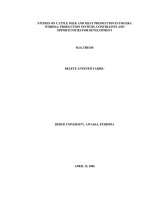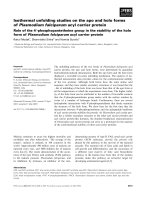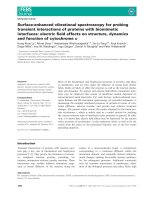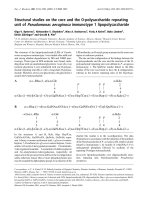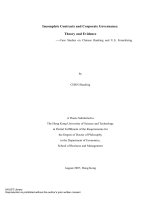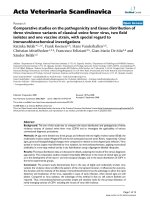Studies on structures, dynamics and interactions with small molecules of CNS regeneration inhibitory components associated with nogo a and epha4
Bạn đang xem bản rút gọn của tài liệu. Xem và tải ngay bản đầy đủ của tài liệu tại đây (7.95 MB, 189 trang )
Studies on Structures, Dynamics and
Interactions with Small Molecules of CNS
Regeneration Inhibitory Components
Associated with Nogo-A and EphA4
QIN HAINA (M. ENG.)
A THESIS SUBMITTED FOR DOCTOR OF PHILOSOPHY
DEPARTMENT OF BIOLOGICAL SCIENCES
NATIONAL UNIVERSITY OF SINGAPORE
2011
Acknowledgements
My deepest gratitude goes first and foremost to my supervisor, A/P Song Jianxing,
for his constant encouragement and guidance. During these years, he has given me
valuable suggestions on my project and always be very helpful no matter I am in any
difficult situation. I am grateful to him not only for his scientific guidance but also
emotional support. His enthusiasm and integral view on research have made a deep
impression on me. Without his consistent support and illuminating instructions, it is
impossible for me to finish my PhD study at this time.
Second, I would like to express my heartfelt gratitude to all my labmates, Shi Jiahai,
Li Minfen, Liu Jingxian, Ran Xiaoyuan, Zhu Wanlong, Huan Xuelu, Wang Wei,
Hong Ni, Shaveta Goyal, Lua Shixiong, Miao Linlin, Wang Xin, Ng Huiqi, Gavita
Gupta. They gave me such warm friendship and valuable advices to me. In particular I
am grateful to Dr Jingsong Fan for NMR experiment training and collecting NMR
spectra on the 800 MHz and 500MHz spectrometer.
I also thank my beloved family for their loving considerations and great confidence
in me all through these years.
Lastly, I am grateful to National University of Singapore for providing me research
scholarship, which enabled me to complete my PhD degree without financial worry in
Singapore.
II
TABLE OF CONTENTS
Acknowledgements I
Table of Contents II
Abstract VII
Abbreviation XI
List of Figures XIII
List of Tables XVII
Chapter I INTRODUCTION 1
1.1 Biological Background 2
1.1.1 CNS Injury 2
1.1.2 Mechanisms that inhibit axonal regeneration 2
1.1.3 Inhibitors from glial scar and associated with CNS myeline 3
1.1.3.1 Inhibitors by components of the glial scar 4
1.1.3.2 Inhibitors associated with CNS myeline 4
1.1.4 NogoA as an Inhibitors of Axon Regeneration in CNS 6
1.1.5 Eph and ephrin and their function in axon regeneration in CNS 8
1.1.6 Eph/ephrin functions in axon regeneration 11
1.1.7 Structure of Eph receptor and its complex with ephrins ligands 12
1.1.8 Organic compounds as small antagonist of EphA4 15
1.1.9 Dynamics study of proteins 16
1.2 Protein NMR 17
III
1.2.1 Physical basis of NMR spectroscopy 17
1.2.2 Chemical shift 20
1.2.3 J coupling 22
1.2.4 NOE (Nuclear Overhauster Effect) 23
1.2.5 NMR relaxation and protein dynamics 24
1.2.6 Structure determination by NMR 25
1.2.6.1 Assignment (backbone and side chain) and restraints (distance,
dihedral angle) 26
1.2.6.2 Structure calculation and evaluation 30
1.3 Objectives and Contributions 32
Chapter II MATERIALS AND METHODS 35
2.1 Vector construction 36
2.2 Protein expression and purification 36
2.3 NMR sample preparation, NMR structure determination, relaxation
experiments and data analysis 37
2.4 Crystallization, data collection, and structure determination 41
2.5 CD experiments and sample preparation 44
2.6 Isothermal Titration Calorimetry and NMR titration 44
2.7 Docking and modelling 45
IV
Chapter III RESULTS AND DISCUSSION 48
3.1 WWP1 and Nogo-A Interaction 49
3.1.1 Identification of WWP1 as a novel binding partner for Nogo-A 50
3.1.2 Preliminary CD and NMR characterization 51
3.1.3 ITC measurements of binding parameters 54
3.1.4 NMR characterization of binding interactions 56
3.1.5 Three dimensional structure and binding interface of the WW4 domain
58
3.1.6 Discussion 62
3.2 Sixteen Structures in Two Crystals Reflect the Highly Dynamic Property of the
Loops of EphA4 Ligand Binding Domain 68
3.2.1 16 structures determined from two EphA4 LBD crystals 69
3.2.2 Comparison between 16 structures and previous EphA4 structures 72
3.2.3 Discussion 77
3.3 Structure Characterization of EphA4-ephrinB2 Complex Reveals New Features
Enabling Eph-ephrin Binding Promiscuity 80
3.3.1 Crystal structure of the EphA4-ephrin-B2 complex 81
3.3.2 Binding interface of the EphA4-ephrin-B2 complex 85
3.3.3 Ligand-binding properties of the EphA4 Gln12/Glu14 mutant 92
3.3.4 Receptor-binding properties of the ephrin-B2Gln109/Glu112 mutant 97
V
3.3.5 NMR visualization of structural perturbations occurring in EphA4 upon
ephrinB2 binding 99
3.3.6 Discussion 103
3.4 Interactions of EphA4 Ligand Binding Domain with Two Small Molecule
Antagonists 108
3.4.1 Binding interactions characterized by ITC and CD 109
3.4.2 Binding interactions characterized by NMR 113
3.4.3 Molecular docking 115
3.4.4 Discussion 121
3.5 NMR Structure and Dynamics of EphA4 Ligand Binding Domain 126
3.5.1 Generation and structural properties of the EphA4 LBD 127
3.5.2 Chemical shift assignment of EphA4 LBD 130
3.5.3 Secondary structure characterization by chemical shift 130
3.5.4 NMR solution structure of EphA4 LBD 132
3.5.5 Comparison of NMR solution structure and crystal structure 137
3.6.6 Dynamics study of free EphA4 and analysis of relaxation data 139
3.7.7 Modelfree analysis of relaxation data 142
3.5.8 Discussion 144
Chapter IV CONCLUSION AND FUTURE WORK 155
VI
4.1 Summary 156
4.2 Key contributions 156
REFERENCE 161
PUBLICATION 173
VII
Abstract
The re-growth of injured neurons in CNS (central nervous system) is largely
inhibited by the non-permissive environment around, and indeed several growth
inhibitors have been identified so far. My thesis is aimed to study structures,
dynamics and protein-protein interactions, as well as protein-small molecule
interactions for two CNS regeneration inhibitors: Nogo-A and EphA4 receptor.
Intracellular Nogo-A protein level is believed to correlate with stroke, as well as
other neurodegenerative diseases such as amyotrophic lateral sclerosis (ALS) and
Alzheimer’s disease. Thus, it is of great interest to understand the mechanism of how
Nogo-A protein level is regulated in vivo. An E3 ubiquitin ligase WWP1 was
identified to be a novel interacting partner for Nogo-A both in vitro and in vivo, and
down-regulated Nogo-A protein level by initiating the ubiquitination of Nogo-A. By
using CD, ITC, and NMR, we have further conducted extensive studies on all four
WWP1 WW domains and their interactions with a Nogo-A peptide carrying the only
PPxY motif. Moreover, the solution structure of the best-folded WW4 domain is
determined, and the binding-perturbed residues were derived for both WW4 and
Nogo-A (650-666) by NMR HSQC titrations. On the basis of the NMR data, the
complex model is constructed by HADDOCK 2.0. This study provides rationales as
well as a template for further design of molecules to intervene in the WWP1-Nogo-A
interaction which may regulate the Nogo-A protein level by controlling its
ubiquitination.
EphA4 was proved to play key roles in the inhibition of the regeneration of injured
axons, synaptic plasticity, platelet aggregation, and so on. In addition, EphA4 has
unique ability to bind all ephrins including 6 A-ephrins and 3 B-ephrins. Therefore,
studies of EphA4 structure, dynamics, and its interaction with ephrin ligands and
VIII
small molecules will be critical in understanding mechanisms underlying the binding
between Eph receptor and ephrin ligands as well as molecule design targeting disease-
involved Eph receptors. Both crystal and NMR structures of free EphA4 LBD were
resolved, revealing the highly dynamic property of loops that comprising the classical
binding pocket. Dynamics study shows that the whole EphA4 ligand binding domain
undergoes dramatic conformational exchanges on µs-ms time scales. These results
may have crucial implications in understanding why EphA4 owns a unique ability to
bind all 9 ephrins. The results with EphA4 dynamics may also help to design and
optimize small molecule agonists and antagonists with high affinity and specificity for
EphA4. The crystal structure of the EphA4-ephrin-B2 complex was also determined
and an additional interaction surface was identified which will enhance the affinity
and specificity of the interclass binding. These findings contribute to our
understanding of the distinctive binding determinants that characterize selectivity
versus promiscuity of Eph receptor-ephrin interactions and suggest that diverse
strategies may be needed to design antagonists for effectively disrupting different
Eph-ephrin complexes. The first two small molecules which antagonize ephrin-
induced effects on EphA4-expressing cells were also presented in our work. Their
binding with EphA4 LBD were studied by ITC, NMR and computer docking. Our
results demonstrate that the high-affinity ephrin-binding pocket of the Eph receptors
is amenable to targeting with small molecule antagonists and suggest avenues for
further optimization.
IX
Abbreviations
(RP-)HPLC (Reversed-Phase) High Performance Liquid
(θ)MRW Mean Molar Ellipticity per Residue in CD
1J/ 2J / 3J Scalar Coupling Through One Bond/ Two bonds/
ALS Amyotrophic Lateral Sclerosis
AU Asymmetric Unit
CD Circular Dichroism
CNS Central Nervous System
DNA Deoxyribonucleic Acid
DTT Dithiothreitol
dαN/ dβN / dNN NOE Connectivity Between CαH/ CβH/ NH with NH
E.coli Escherichia coli
Eph receptors Erythropoietin-Producing Human
EphA4 LBD EphA4 Ligand Binding Domain
ER Endoplasmic Reticulum
FID Free Induction Decay
GST Gluthathione S-transferase
Haddock High Ambiguity Driven protein-protein Docking
X
HSQC Heteronuclear Single Quantum Coherence
IPTG Isopropyl β-D-thiogalactopyranoside
ITC Isothermal Titration Calorimetry
LB Luria-Bertani
NMDA receptor N-methyl D-aspartate receptor
NMR Nuclear Magnetic Resonance
NOE Nuclear Overhauster Effect
NOESY Nuclear Overhauser Enhancement Spectroscopy
OD Optical Density
PBS Phosphate-buffered Saline
PCR Polymerase Chain Reaction
PEG Polyethylene Glycol
RMSD Root Mean-square Deviation
SDS-PAGE Sodium Dodecyl Sulphate Polyacrylamide Gel
TOCSY Total Correlation Spectroscopy
UV Ultraviolet
WWP1 WW domain-containing protein 1
XI
List of Figures
Figure 1.1 Schematic representation of the CNS injury site (Glenn Yiu, et al, 2006)
Figure 1.2 Glial inhibitors and intracellular signalling mechanism (
Glenn Yiu, et al,
2006
)
Figure 1.3 Schematic representation of Nogo family (
Oertle, T. et al, 2003)
Figure 1.4 NMR solution structure of Nogo-66 (Li M et al, 2004)
Figure 1.5 Schematic representation of Nogo-A degradation (
Qin H. et al, 2008)
Figure 1.6 Eph receptor structure and signalling (
Yona Goldshmit et al, 20)
Figure 1.7 Eph and ephrin function after spinal cord and optic nerve injury in mice
(
Yona Goldshmit et al, 2004)
Figure 1.8 Correlation between chemical shift deviation and 2
nd
structure (Wishart DS
et al, 1994
)
Figure 1.9 Correlation between J-coupling and 2
nd
structure (A. Pardi et al, 1984)
Figure 1.10 NOE patterns associated with protein 2
nd
structure (Wuthrich K, 1986)
Figure 1.11 Flow chart of structure determination
Figure 1.12 Sequential assignment by CBCACONH, HNCACB
Figure 1.13 Sequential assignment by CBCACONH, HNCACB
Figure 1.14 Side chain assignment by HCCH-TOCSY
Figure 1.15 NOE assignment by
15
N-NOESY
XII
Figure 1.16 Flow chart of structure determination by software
Figure 3.1 Schematic representation of the modular structure of WWP1 protein
Figure 3.2 Structural and binding characterization of the fWW protein
Figure 3.3 Binding of four
15
N-labeled WW domains with Nogo-A (650-666)
Figure 3.4 ITC titration profiles of the binding reactions of the WW1, WW2, WW3,
and WW4 domains with Nogo-A
Figure 3.5 Binding of
15
N-labeled Nogo-A(650-666) with the WW4 domain
Figure 3.6 Binding of the
15
N-labeled WW4 domain with Nogo-A (650-666)
Figure 3.7 Structures of the free and complexed WW4 domains
Figure 3.8 Pattern of EphA4 LBD clusters
Figure 3.9 Comparison between 16 EphA4 LBD structures
Figure 3.10 Comparison between 16 EphA4 LBD structures and open/closed
conformations
Figure 3.11 Comparison of the interactions between EphA4/EphA4, and
EphA4/ephrinB2
Figure3.12 Stereo view of J-K and D-E loops built into the simulated annealing 2Fo-
Fc electron density map contoured at 1.0σ
Figure 3.13 Crystal structure of the EphA4-ephrin-B2 complex
Figure 3.14 ITC characterization of WT-EphA4 and mutated EphA4 binding with
ephrinB2 and compound1 and 2
XIII
Figure 3.15 Anatomy of the EphA4-ephrin-B2 binding interface
Figure 3.16 Sequence alignment of part of the ligand binding domains of Eph
Receptors
Figure 3.17 Structures of the Eph-ephrin complexes
Figure 3.18 Unique features for the EphA4-ephrin-B2 complex
Figure 3.19 CD and NMR characterization of EphA4 and ephrin-B2 mutants
Figure 3.20 Binding properties of EphA4 and its mutant to different ephrin ligands
(Data from collaborator’s group, R. Noberini, JBC, 2009)
Figure 3.21 Binding properties of wide type and mutated ephrin ligands with Eph
receptors (Data from collaborator’s group, R. Noberini, JBC, 2009)
Figure 3.22 NMR HSQC mapping of the binding interfaces of EphA4WT/ephrinB2
and EphA4Mut/ephrinB2
Figure 3.23 Binding interfaces of EphA4WT / ephrinB2 and EphA4Mut / ephrinB2
mapped out by NMR
Figure 3.24 The ITC titration profiles of the binding reaction of the EphA4 ligand
binding domain with compound 1and compound 2
Figure 3.25 Characterization of the interactions with two small molecule antagonists
Figure 3.26 Models of EphA4 (chainA) in complex with small molecule antagonists
Figure 3.27 Models of EphA4 (chainB) in complex with small molecule antagonists
Figure 3.28 EphA4 binding pocket for the small molecule antagonists
XIV
Figure 3.29 Structure characterization of EphA4 by CD and NMR spectrum
Figure 3.30 EphA4 LBD chemical shift deviation from random coil value
provides insights in its secondary structure
Figure 3.31 Structure ensemble of EphA4 solved by NMR spectroscopy
Figure 3.32 NOE distribution of EphA4 ligand binding domain
Figure3.33 Sequential NOEs plotted against amino acid sequence
Figure 3.34 Stereo view of the comparison of EphA4 ligand-binding domain crystal
structures
Figure 3.35 Stereo view of the comparison between NMR solution structure and X-
ray structure
Figure 3.36 The 15N NMR backbone relaxation data of the EphA4 ligand binding
Domain
Figure3.38 Backbone order parameter (S2) and Rex determined from 15N relaxation
data using fully-anisotropic model
XV
List of Tables
Table 1.1 Properties of nuclei of interest on NMR studies of proteins
Table 1.2 Active residues and flexible regions used in docking of WW domain and
nogo-A polyproline peptide
Table 3.1 Secondary Structure Fraction Prediction Based on far-UV CD Spectrum
Table 3.2 Thermodynamic Parameters of the Binding Interactions between four
WWP1 WW Domains and Nogo-A (650-666) as Measured by Isothermal Titration
Calorimetry (ITC)
Table 3.3 Structural statistics for 10 selected NMR structures of the WW4 domain
Table 3.4 Crystallographic data and refinement statistics of EphA4 LBD structures
Table 3.5 Crystallographic data and refinement statistics of EphA4-ephrinB2
complex
Table 3.6 Thermal dynamic parameters of the binding interactions between the wide
type and mutated EphA4 receptors and ephrinB2 as well as two small antagonists by
ITC Crystallographic data and refinement statistics for the EphA4-ephrinB2 complex
structure
Table 3.7 Thermodynamic parameters for the binding interactions between EphA4
and two small molecules by ITC
Table 3.8 Structural statistics for 10 selected NMR structures of EphA4 LBD
Table 3.9 Relaxation data of EphA4 LBD
1
Chapter I INTRODUCTION
2
1.1 Biological background
1.1.1 CNS injury
CNS (Central Nervous System, including brain and spinal cord) injuries, induced
by stroke, traumatic injury, or neurodegenerative diseases, could be permanently
disabling because the transected axons in CNS could not regenerate beyond the lesion
site. Potential consequences of these CNS injuries include memory loss, inability to
concentrate, speech problems, motor and sensory deficits, and behavioural problems.
Each year in the United States, more than 2 million people suffer from traumatic brain
injuries, over 500,000 people suffer from stroke, and at least 10,000 people suffer
from spinal cord injuries. So far, the primary treatments are based on physiotherapy
and it is estimated that only 0.9 % of the patients will have completed neurological
recovery. Therefore, there is a huge unmet medical need for treating CNS injury.
1.1.2 Mechanisms that inhibit axonal regeneration
It was observed long ago that unlike axons in peripheral nervous system, severed
axons in the CNS do not have the ability to grow significant distance (Ramon, 1928).
Moreover, the study in 1980 showed that the peripheral nerve implanted in CNS can
not grow out of long distance (Weinberg EL, 1980). Thus, the failure of axons in CNS
to regenerate is due to the non-permissive environment they inhabit. If the inhibitory
factors could be removed or blocked, or if suitable growth-promoting agents added,
the axons might re-grow through the lesion site.
3
Several growth inhibitors have been identified which are either components of the
extracellular matrix present in the glial scar or molecules associated with CNS
myeline.
Figure1.1 Schematic representation of the CNS injury site (Glenn Yiu, et al, 2006).
1.1.3 Inhibitors from glial scar and associated with CNS myeline
Injury to the adult CNS often results in the transection of nerve fibres and damage
to surrounding tissues. The distal ends of the severed axons form characteristic
dystrophic growth cones that are exposed to the damaged glial environment. During
the early phase of injury, myelin associated inhibitors from intact oligodendrocytes
and myelin debris can restrict axon regrowth. Recruitment of inflammatory cells and
reactive astrocytes over time leads to the formation of a glial scar, often accompanied
by a fluid-filled cyst. This scarring process is associated with the increased release of
chondroitin sulphate proteoglycans, which can further limit regeneration. Together,
4
these molecular inhibitors of the CNS glial environment present a hostile environment
for axon (Glenn Yiu et al, 2006).
1.1.3.1 Inhibitors by components of the glial scar
Key classes of inhibitory molecules are 1) Chondroitin sulphate proteoglycans; 2)
ephrins; 3) semaphorins. All of them are up-regulated after injury. Chondroitin
sulphate proteoglycans are components of the CNS extracellular matrix; the precise
mechanism by which they cause growth inhibition is not known, but the fact that they
do so is well established (McKeon RJ et al, 1995; Snow DM et al, 1990). Ephrins and
their Eph receptors are a family of membrane proteins that are involved in axon
guidance during development, but are also present in the CNS in adulthood. Binding
of ephrins on one cell to their receptors on another activates bidirectional signalling
pathways that in neurons lead to the collapse of the growth cone (Holland SJ et al,
1996). Semaphorins are a large family of membrane-bound and secreted proteins that
are also involved in axon guidance during development. Upregulated production of
Sema-3A by the meningeal cells that migrate in to form the lesion core is again
inhibitory to axonal growth (De Winter F et al, 2002).
1.1.3.2 Inhibitors associated with CNS myeline
Cultured neurons grow readily on substrates of myelin extracted from peripheral
nerve, but not on beds of mature oligodendrocytes or isolated CNS myelin (Schwab
ME et al, 1988). The proteins Nogo-A (Chen MS et al, 2000) and myelin-associated
5
glycoprotein have been identified as mediators of the growth-suppressive effects of
CNS myelin. In addition, oligodendrocytes secrete the inhibitory protein tenascin R.
My thesis puts emphasis on Nogo-A, a widely studied inhibitor, and EphA4, a
newly discovered agent involved in neuron regeneration. Thus, the following review
will focus on the introduction to these two protein families.
Figure1.2 Glial inhibitors and intracellular signalling mechanism
(Glenn Yiu, et al, 2006).
6
1.1.4 NogoA as an Inhibitors of Axon Regeneration in CNS
Nogo is a member of the reticulon family of membrane proteins, and at least three
isoforms (Nogo-A, -B and -C) are generated by alternative splicing and promoter
usage.
Among these, Nogo-A is best characterized, owing to its high expression in CNS
oligodendrocytes
(Huber, A. B. et al, 2002). Structure–function analyses support the
presence of two inhibitory domains: a unique amino-terminal region (amino-Nogo)
that is not shared by Nogo-B and Nogo-C (Oertle, T. et al, 2003), and a 66 amino acid
loop (Nogo-66) that is common to all three isoforms (Prinjha, R. et al, 2000). Nogo-
66 contains three helices and with the long-range packing between the second and
third helix, whereas the amino terminal region was demonstrated as intrinsically
unstructured (Li M et al, 2006; Li M et al, 2004; Li M et al, 2006).
Figure1.3 Schematic representation of Nogo family (Oertle, T. et al, 2003)
Figure1.4 NMR solution structure of Nogo-66 (Li M et al, 2004)
7
Nogo-A has been demonstrated to be a potent neurite growth inhibitor and plays a
key role both in the restriction of axonal regeneration after injury and in structural
plasticity of the CNS of higher vertebrates. In vivo neutralizing Nogo-A by its
antibody has been shown to enhance sprouting and functional recovery after cervical
lesion in rat and adult primates. In addition, Nogo-A was also identified to be
essential for the tubular network formation of ER (Voeltz G.K. et al, 2006). Most
recently, a role of Nogo-A in synapse integrity has also been suggested and
overexpression of Nogo-A led to destabilization and retraction of nerve terminal
(Jokic N. et al, 2006).
Intracellular Nogo-A protein level is believed to correlate with stroke (Li S. et al,
2006), as well as other neurodegenerative diseases such as ALS (Jokic N. et al, 2005)
and Alzheimer’s disease (Gil V. et al, 2006). These observations indicate that the
intracellular Nogo-A protein level is essential to the functions of Nogo-A in cell. As a
result, it is of significant meaning to know how the Nogo-A protein level is regulated
in vivo.
Recently, our collaborators found that WWP1, an E3 ubiquitin ligase, can interact
with Nogo-A, and initiate the ubiquitination of Nogo-A, subsequently down-regulate
the intracellular Nogo-A protein level. As this phenomenon was also observed at the
axonal sprouting region of the mice stroke model, WWP1 mediated ubiquitination is
likely to play an important role in Nogo-A axon regeneration inhibition. The
investigation of how WWP1 interact with Nogo-A would have significant meaning in
Nogo-A involved neuron diseases by providing the interaction mechanism
information. In my thesis, the binding between WWP1 and Nogo-A was studied by
NMR, ITC, and their binding was modeled by molecular docking.
8
Figure 2.5 Schematic representation of Nogo-A degradation (Qin H. et al, 2008)
1.1.3 Eph and ephrin and their function in axon regeneration in CNS
Eph proteins constitute a large family of receptor tyrosine kinases that bind to
ligands called ephrins. The Eph and ephrin protein families are each divided into A
and B subclasses based on sequence homology, membrane anchorage, and binding
preference for each family member. There are 10 EphA and 6 EphB receptors known
at present, while 6 ephrin-A and 3 ephrin-B proteins have been identified. Ephrin-A
proteins are attached to the cell membrane by a glycophospatidylinositol (GPI) anchor,
while ephrin-B proteins have a transmembrane region and a short, highly conserved
cytoplasmic tail with a PDZ (postsynaptic density-95/Discs large/zona occludens-1)-
binding domain (Martinez A. et al, 2005; Song J. et al, 2002; Torres R. et al, 2008).
Eph receptors consist of a highly conserved N-terminal extracellular ligand binding
domain, followed by a cysteine-rich domain, two fibronectin III repeats, a
juxtamembrane region, and an intracellular kinase domain with a PDZ binding motif
(Flanagan JG et al, 2008).
9
In the nervous system, Ephs and ephrins have been most extensively studied for
their developmental roles in axon guidance, topographic mapping, hindbrain
segmentation, and neural crest cell migration (Wilkinson DG et al, 2005; Henkemeyer
M. et al, 2003). Ephs and ephrins are not only developmental molecules but also play
important role in adult nervous system. Evidence showed that, Ephs and ephrins can
modulate synaptic function by regulating dendritic spine formation (Henkemeyer M.
et al, 2003; Ethell IM et al, 2001; Murai KK et al, 2003), NMDA receptor clustering,
and potentiation of calcium influx (Takasu MA et al, 2002; Dalva MB et al, 2000).
Moreover, Ephs and ephrins also are involved in the proliferation and progenitor cells
in neurogenic regions (Depaepe V et al, 2005; Katakowski M et al, 2005; Ricard J et
al, 2006; Holmberg J et al, 2005; Conover JC et al, 2000; Aoki M et al, 2004).

